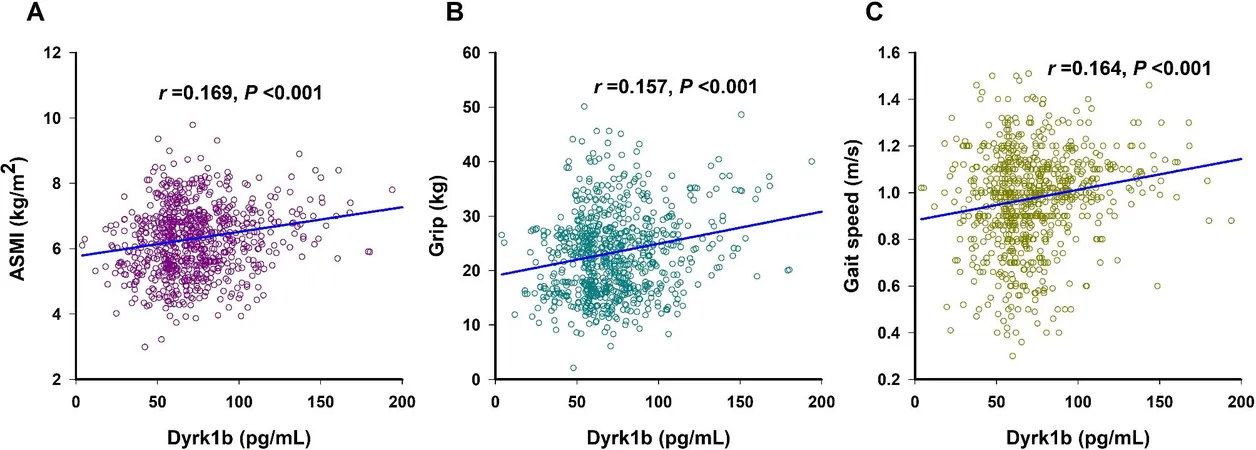
Unlocking a Potential Biomarker: Dyrk1b and Its Role in Elderly Sarcopenia
2025-04-25
Author: William
Understanding Sarcopenia: The Silent Threat to Aging Adults
As we age, one of the most insidious challenges we face is sarcopenia, a debilitating condition marked by the gradual loss of muscle mass and strength. This alarming syndrome affects about 10% of adults over 60, putting them at heightened risk for falls, fractures, and reduced quality of life.
Introducing Dyrk1b: A Key Player in Muscle Health
Enter dual-specificity tyrosine-regulated kinase 1b, or Dyrk1b, a protein that could be the breakthrough we need. Known for its critical role in muscle development and maintenance, Dyrk1b helps regulate processes essential for muscle function and survival. Yet, the link between Dyrk1b levels and sarcopenia has remained a mystery until now.
Revealing New Research Insights
In a groundbreaking study involving 939 community-dwelling older adults, researchers sought to clarify the relationship between serum Dyrk1b levels and sarcopenia. The findings were striking. Individuals with sarcopenia showed significantly lower levels of serum Dyrk1b (median 67.37 pg/mL) compared to their healthy counterparts (70.40 pg/mL), highlighting a clear association.
Predicting Sarcopenia with Dyrk1b
The study identified an optimal Dyrk1b cutoff value of 44.73 pg/mL for predicting sarcopenia. Impressively, this threshold boasted a sensitivity of 94.8%, indicating its potential for early detection. Higher serum levels of Dyrk1b correlated positively with muscle mass, grip strength, and gait speed—all critical indicators of physical health in older adults.
Why Dyrk1b Matters: Implications for Seniors' Health
These findings are significant. With low Dyrk1b levels linked to increased sarcopenia risk, this protein could serve as a valuable biomarker for early screening in elderly populations. Furthermore, understanding Dyrk1b's role in muscle resilience may pave the way for innovative strategies to combat sarcopenia.
Looking Ahead: The Need for More Research
While the implications are promising, further research is necessary to solidify Dyrk1b as a reliable biomarker across diverse populations. Evaluating its relationship with chronic inflammation and metabolic health could be pivotal in framing future interventions against sarcopenia.
Conclusion: A Path Towards Empowering Elderly Health
In summary, Dyrk1b emerges as a formidable player in the battle against sarcopenia, offering a window into preventative healthcare for our aging population. As scientists continue to explore the depths of this protein's functionalities, we inch closer to enhancing the lives of countless seniors facing the challenges of muscle degeneration.









 Brasil (PT)
Brasil (PT)
 Canada (EN)
Canada (EN)
 Chile (ES)
Chile (ES)
 Česko (CS)
Česko (CS)
 대한민국 (KO)
대한민국 (KO)
 España (ES)
España (ES)
 France (FR)
France (FR)
 Hong Kong (EN)
Hong Kong (EN)
 Italia (IT)
Italia (IT)
 日本 (JA)
日本 (JA)
 Magyarország (HU)
Magyarország (HU)
 Norge (NO)
Norge (NO)
 Polska (PL)
Polska (PL)
 Schweiz (DE)
Schweiz (DE)
 Singapore (EN)
Singapore (EN)
 Sverige (SV)
Sverige (SV)
 Suomi (FI)
Suomi (FI)
 Türkiye (TR)
Türkiye (TR)
 الإمارات العربية المتحدة (AR)
الإمارات العربية المتحدة (AR)